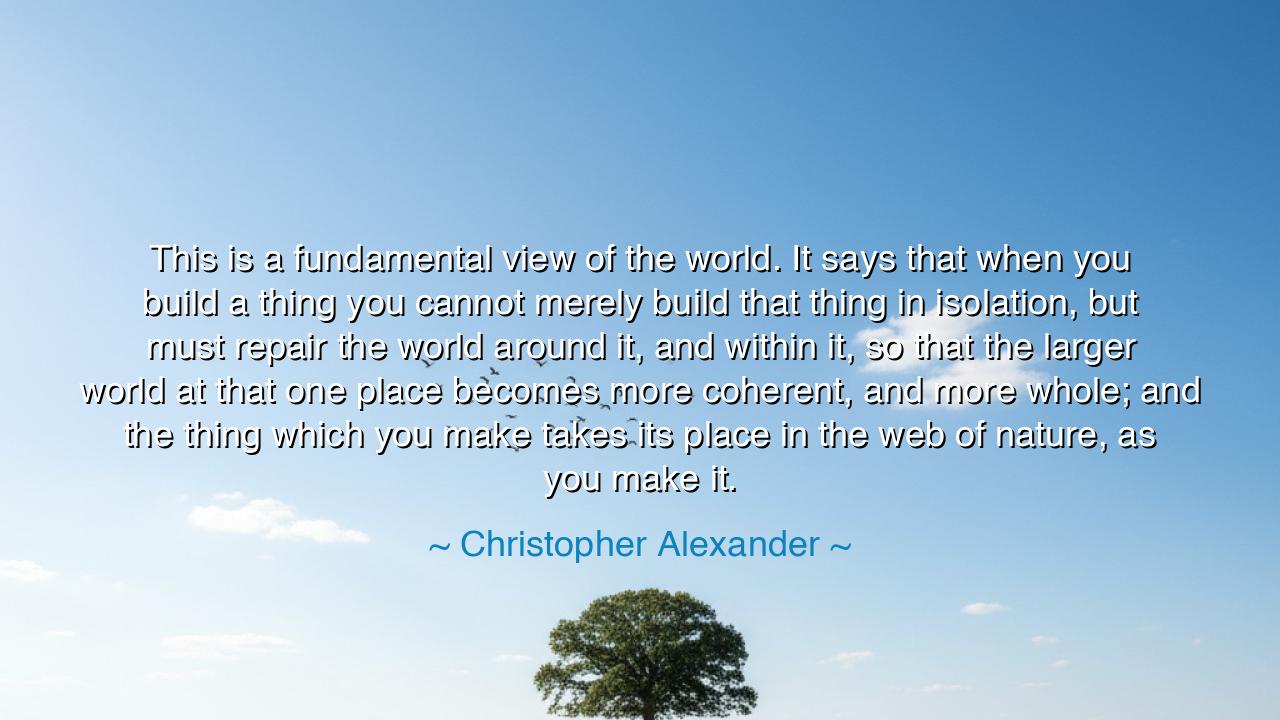
This is a fundamental view of the world. It says that when you
This is a fundamental view of the world. It says that when you build a thing you cannot merely build that thing in isolation, but must repair the world around it, and within it, so that the larger world at that one place becomes more coherent, and more whole; and the thing which you make takes its place in the web of nature, as you make it.






Hear the wisdom of Christopher Alexander, the master builder of patterns, who proclaimed: “This is a fundamental view of the world. It says that when you build a thing you cannot merely build that thing in isolation, but must repair the world around it, and within it, so that the larger world at that one place becomes more coherent, and more whole; and the thing which you make takes its place in the web of nature, as you make it.” These words strike like a bell across the centuries, reminding us that creation is never solitary, and that to make is also to heal.
For every act of building—whether a house, a bridge, a poem, or even a friendship—ripples outward. Nothing stands alone. A wall changes the way the wind moves, the way people gather, the way silence falls. A word spoken shifts the spirit of the hearer, and through them, the world itself. To believe one can create “in isolation” is a lie of the proud; all creation must weave itself into the larger web of nature. To build wisely is to seek not only the completion of the thing itself, but the repair of the world in which it stands.
The ancients knew this. When the builders of the Parthenon set stone upon stone, they aligned its columns not only with their own design but with the hills, the sea, the light of the Attic sun. The temple did not sit as an intruder upon the land—it belonged to it, amplified it, and gave it harmony. And when the artisans of Japan crafted their tea houses, they shaped not just walls and roofs, but spaces of stillness, gardens of moss and water, where the human spirit could find peace in unity with the earth. In both, we see Alexander’s truth: that a thing made well becomes more than itself; it repairs the world at the point where it is set.
But history also warns of the opposite. Consider the concrete jungles of the modern age, where towers are built only for profit, without regard for light, air, or human soul. These structures are not healing but wounds upon the earth. They bring not coherence, but fracture. They remind us of what Alexander despised: things built in arrogance, torn from the rhythms of nature, deaf to the needs of people, blind to the greater whole.
The teaching here is not limited to architects and builders, but applies to all creation. A song that ignores truth may charm for a moment but leaves the heart emptier than before. A law written without justice may order society, but in doing so, it fractures its spirit. A tool fashioned without care for the worker becomes a burden, not a blessing. In every act of making, we must ask: does this repair the world, or does it wound it further?
The lesson, then, is clear: every act of creation carries responsibility. If you build, build not in isolation. Look around, look within, and see what is broken. Shape your work so that it heals, so that it strengthens coherence, so that it belongs to the great web of nature. Do not seek only the perfection of the thing, but the harmony of its place within the living whole. In this lies true artistry, true morality, and true wisdom.
Therefore, O children of tomorrow, take these words as a law of life: when you make, do not merely make—repair. When you speak, let your words bind wounds. When you build, let your structures give life. When you act, let your actions create harmony. For nothing in this world is truly isolated; all things are threads in the same tapestry. To create is to heal, and to build rightly is to repair the world.






AAdministratorAdministrator
Welcome, honored guests. Please leave a comment, we will respond soon